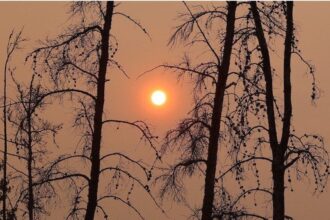The acrid smell of wildfire smoke has become an unwelcome summer companion for many Canadians in recent years. As climate change intensifies extreme weather events, understanding Canada’s Air Quality Health Index (AQHI) has shifted from optional knowledge to essential information for public health.
“The AQHI was developed specifically to help Canadians protect their health during air quality events,” explains Dr. Sarah Cooke, environmental health specialist at the University of British Columbia. “What many people don’t realize is that it measures multiple pollutants simultaneously, not just smoke particles.”
The index, which ranges from 1 to 10+, measures concentrations of ground-level ozone, particulate matter, and nitrogen dioxide—pollutants that can cause serious respiratory and cardiovascular complications. When ratings climb above 7, even healthy individuals may experience breathing difficulties, while vulnerable populations face substantially higher risks.
Environment Canada issues these ratings alongside practical recommendations that change with escalating numbers. At levels 1-3 (low risk), most Canadians can continue normal outdoor activities. Between 4-6 (moderate risk), sensitive groups should consider reducing strenuous outdoor exertion. Once readings exceed 7, public health officials advise everyone to limit outdoor exposure.
For vulnerable populations—including children, seniors, pregnant women, and those with pre-existing respiratory or heart conditions—these warnings carry particular weight. Studies published in the Canadian Medical Journal show that hospital admissions for asthma and COPD exacerbations increase by approximately 12% during high AQHI events.
Toronto respirologist Dr. Michael Chen notes that real-time AQHI monitoring has become increasingly crucial. “We’re seeing patients who never realized they had sensitivities until extended exposure to poor air quality triggered symptoms,” he told CO24 News. “Knowing the current AQHI rating allows everyone to make informed decisions about outdoor activities.”
Climate scientists tracking Canada’s air quality patterns have documented a troubling trend: the frequency of high AQHI days has increased by nearly 40% over the past decade, with western provinces experiencing the sharpest rise due to intensifying wildfire seasons.
Beyond the immediate health impacts, economists at the University of Toronto estimate that reduced productivity from air quality events costs the Canadian economy approximately $5.3 billion annually—a figure expected to grow as climate impacts worsen.
Residents can access real-time AQHI information through Environment Canada’s website, weather apps, or provincial air monitoring services. Many municipalities have also implemented alert systems that send notifications when air quality deteriorates significantly.
Health experts recommend keeping windows closed during poor air quality events and using HEPA air purifiers when possible. For those who must venture outdoors, properly fitted N95 masks can filter most harmful particles, though they don’t protect against all pollutants.
As we navigate increasingly common air quality challenges, one question remains particularly relevant: How will Canadian infrastructure and health systems adapt to the growing frequency of these events in the decades ahead?
























